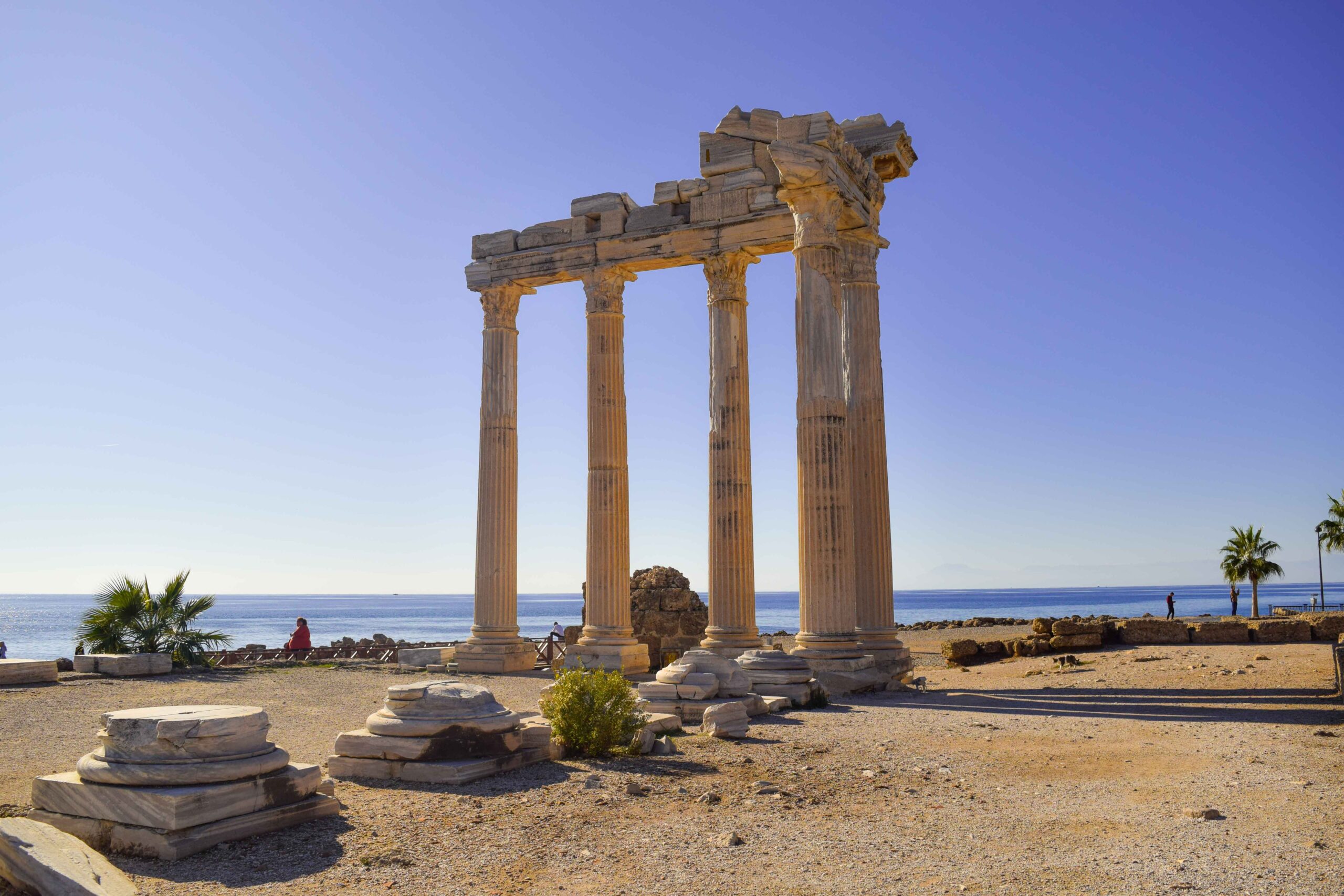If the iconic architecture of Istanbul and the cave dwellings of Cappadocia, have enticed you to make your plans for Turkey, do yourself a favor and add the cascading travertine terraces of Pamukkale to your list too. Pamukkale is a unique destination. Stretching for over a mile and a half, these dazzling white travertines and hot springs of calcium carbonate look splendid against the green Turkish countryside. It’s so easy to laze around in these sweeping limestone white cliffs, with dazzling blue pools. The whole experience is definitely more than being at some embellished geological formation. And possible nowhere on earth you can find such immaculately designed natural formations, with exquisite examples of man’s creations. Next to the pools are the remains of an idyllically located Greek-Roman spa city, Hierapolis.

The white calcite cliffs of Pamukkale adorn the cover page of most Turkey tourism brochures. And these geological wonders invite many day travelers, mostly like me, traveling from the nearest big town Denizli. Denizli is a cosmopolitan town, well connected to every corner of Turkey, and just half an hour bus ride from Pamukkale. The ruins of ancient Hierapolis stand above these dazzling travertines, and centuries ago their inhabitants did the same what the travelers do today, laze around in these warm water pools.
I left Denizli around mid-day. Pamukkale is well connected, and my couch-surfing host had instructed me to take the lower gate for the site. It is less crowded and gives the unique opportunity to capture the gleaming beauty of the pools from different angles. Well, Pamukkale looks quite different from the way they show in the pictures, those are highly edited. Nonetheless, this site looks beatifically splendid, and in true words, enchanting.
Over-tourism had led to the destruction of the pools, and then Pamukkale was overtaken by UNESCO to restore it to its original beauty. The source of these thermal pools is higher up, and the evaporation of this highly calcite-laden water on the cliffs has led to the formation of these travertines, which look a little like a succession of small cotton clouds. And thus the name Pamukkale, which in Turkish means ‘cotton clouds.



The dusty ways to the ancient spa-town
Beautiful is just too easy a word for Pamukkale, a place that became my sole reason to cover this western edge of Turkey, instead of routing my way through the spiritual capital Konya and then to Anatolia. But honestly, I was equally excited to be at the ruins of Hierapolis, the colonnaded streets, temples, bathhouses, necropolis, and theatre in this once Greek-Roman spa city. A walk through the ancient city opens so many pages of history and helps understand how Pamukkale remained both a natural and human show of pomp and splendor.
The ancient spa town of Hierapolis was founded in the 2nd century BC by Attalides of Pergamum. Destroyed and then rebuilt, this town with an eloquent mix of Greek and Roman architectural design is a real treasure. And the real charm is the amphitheater, which also remains in the most intact form as of today. The perfect example of a Greek amphitheater. There are distinct differences between the Greek and Roman amphitheaters – the most distinguishable being their position from the ground. Greek theatres were carved out of a hillside while Roman theatres were built up from the solid ground. Also in Greek theatres, the orchestra is larger because the structures were used for other events which required more space.

And the amphitheater is the only place where you will find some travelers, the other ruins and structures, mostly scattered around, are usually lonely spaces offering insight into the then era. And the further we go, the more alone we are! But keep going, the ruins have interesting insights to offer. From the amphitheater follow the trail to the Church, where Mother Mary is said to have breathed her last, and then come down to the columned ruins of the ancient city.
Follow the trail to the main street, the Frontinus Street which was Hierapolis’ main street. It connects the Central Hamam area to the Necropolis and the North Gate. On sides, you can find well-preserved ruins of numerous buildings such as shops, houses, warehouses, a fountain building, and latrines, all unified by a 170-meter long travertine façade. Another significant reminder of the architectural dexterity of that era is the central Hamam area. The Central Hamam was built in the 2nd century AD, and only a small part of it is accessible, which houses the on-site archaeological museum.
Move north from the Frontinus Street, and there are remnants of the old city, and that brings to one more untold tale of Hierapolis. Many people used to come to Hierapolis to retire or die and the site has a large necropolis filled with sarcophagi, the most famous being the tomb of Marcus Aurelius. The street further up the North Gate has many such tombs.
These ruins are quite spread out, and it is a good walk to cover all the areas of interest. But for a history buff, there are enough tales and signs to keep one occupied, and in a click frenzy state.






The scared pool of Cleopatra
The thermal water of Pamukkale once supplied the ancient city of Hierapolis, which earned it the reputation of a spa town, the envy of its enemies, and invited nobles from across the region to bathe in the therapeutic water in the hope of curing ailments. Legend has it that when Cleopatra visited Hierapolis, she bathed in the thermal waters and claimed that the water had removed all her wrinkles. Albeit the legend has faded, the pool remains and remains a quick draw for travelers. And so when in Pamukkale, there’s always a way to test Cleopatra’s claim of discovering the fountain of youth.

There are actually very few words that come to mind while describing Pamukkale, it’s a whole spectrum of emotions. Should I call it a place where nature has taken a lead to play the artist with white travertine cascades resembling frozen waterfalls and terraces of shallow pools, or is it the munificence of man’s creativity, and desire of health and beauty, or is it some perfect spot that brings and blends in these two powers together? My last thoughts as I edged out of this unique place were different from the ones I brought along. I came in search of an enticing natural marvel, I came out as more learned and educated of how our deeply our history is itched with these tales of desire to acquire the best lands, find exotic ways to remain young, beautiful, and powerful, and fashion cities that narrate our desire of perfection.









